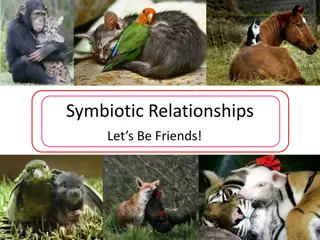Understanding Symbiotic Relationships in Nature
Symbiotic relationships are intricate connections between different species where they benefit from each other. Mutualism, commensalism, and parasitism showcase the diverse ways organisms interact. Examples like decorator crabs with sponges, proboscis butterflies with flowers, and barnacles on whale
1 views • 22 slides
External Morphology and Functions of Balanoglossus
Balanoglossus is an elongated, wormlike animal with a unique body structure divided into proboscis, collar, and trunk regions. The body wall consists of an outer epidermis, inner musculature, and peritoneum, providing protection and support. The proboscis is a club-shaped structure, the collar conta
0 views • 7 slides
Anatomy and Characteristics of House Flies
Explore the intricate details of Musca (House Fly) including its scientific classification, mouth parts, aristate antenna, wings, legs, abdomen, and ovipositor. Discover unique features such as the modified labium into a proboscis, halteres aiding in orientation, sticky pads on legs for clinging, an
0 views • 11 slides
Fascinating Facts About Honey Bees
Discover the incredible world of honey bees, including their three types or castes, body regions, unique features like compound and simple eyes, antennae, proboscis, and mandibles. Explore how their thorax enables flight with four wings, and learn about the speed and agility of these remarkable inse
0 views • 21 slides
Salient Characters and General Features of Phylum Acanthocephala
Discover the salient characters and general features of Phylum Acanthocephala, a group of parasitic organisms with unique anatomical characteristics. Explore the body structure, presence of a retractable proboscis, absence of body segmentation and alimentary canal, as well as the lack of certain org
0 views • 10 slides




